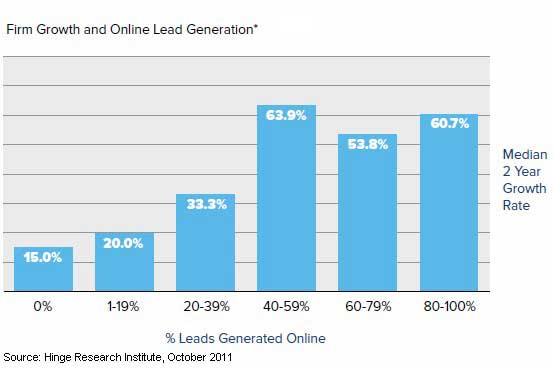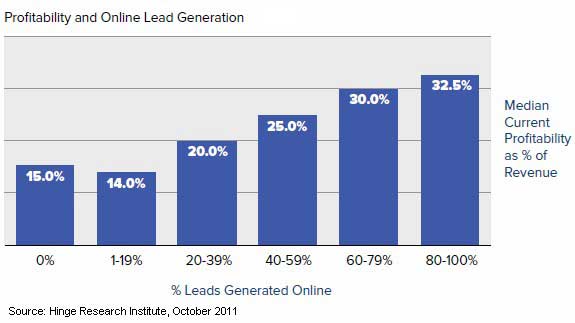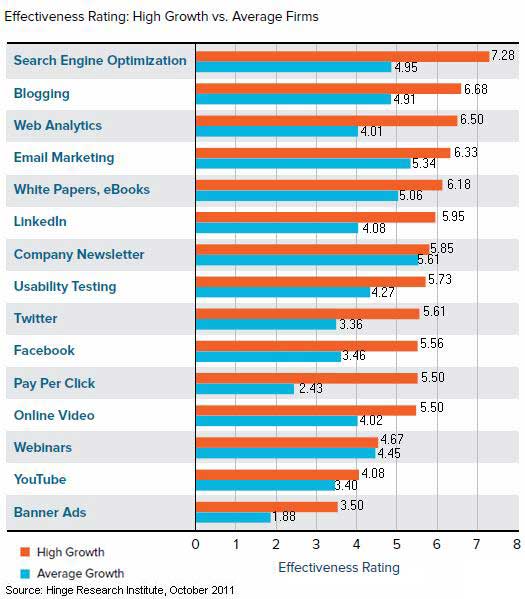Professional services companies that generate a large proportion of business leads via online sources grow faster and more profitably than firms without such lead capabilities, according to a new study by Hinge Marketing, which also found that SEO, blogging, and Web analytics are among the most effective online marketing tools for such high-growth firms.
Below, additional findings from the study titled "Online Marketing for Professional Services Firms: How Professional Services Firms Can Achieve High Growth and Profits with Online Marketing," based on a survey of 500 professional services companies.
Among professional services firms surveyed, 77.1% generate at least some new-business leads online; most (48%) generate less than 20% of total leads online and nearly one-quarter (22.9%) generate no leads via online sources.

However, 14.8% of firms generate 40% or more of their new business leads online and such firms lead the pack in business growth and profitability.
Impact on Growth
For example, among companies that generate 40-59% of leads online, the median two-year growth rate is 63.9%, compared with 15% among those that generate no leads online. That balanced approach of traditional and online marketing strategies may represent a "sweet spot" that creates optimal results:
Impact on Profitability
The percentage of leads generated online directly correlates with profitability: Firms that generate less than 20% of leads online tend to be less profitable than the others, whereas those that generate 80-100% of leads online tend to be more profitable with a profit level at 32.5% of annual revenue:

Why are such businesses more profitable?
The data do not provide a definitive answer, the study notes, but one explanation is that online marketing simply costs less than traditional marketing over the long term. For example, consider a firm that makes an upfront investment in search engine optimization. Once the firm achieves top search engine rankings, the leads continue to flow in without incurring high ongoing costs.
By contrast, traditional marketing techniques often require sustained campaign expenses.
Top Industries
Marketing and communications companies are leading the pack, generating 31.4% of leads online. Technology service businesses are second with 20.2%, followed by management consulting (15.9%), accounting services (11.4%), and the A/E/C community (architecture, engineering, and construction) (8.3%).
Use of Online Techniques
Survey participants were asked to rate 15 online marketing techniques according to how much focus their firm placed on each one.
Among average-growth firms, the top tools are email marketing (5.43), LinkedIn (4.93), company newsletters (4.18), SEO (4.06), white papers and ebooks (3.82), and Web analytics (3.63). Low priority tools among average-growth firms are YouTube (1.94), pay-per-click (PPC) advertising (0.76), and banner ads (0.47).
Looking for great digital marketing data? MarketingProfs reviewed hundreds of research sources to create our most recent Digital Marketing Factbook (May 2010), a 296-page compilation of data and 254 charts, covering email marketing, social media, search engine marketing, e-commerce, and mobile marketing. Also check out The State of Social Media Marketing, a 240-page original research report from MarketingProfs.
SEO, Blogging, and Web Analytics Most Effective Among High Growth Firms
Participants were also asked to rate the effectiveness of each technique in helping them accomplish their goals on a scale of 0 to 10 with a rating of 0 indicating an ineffective technique and a 10 indicating a highly effective technique.
Among high-growth firms, SEO (7.28), blogging (6.68), Web analytics (6.50), and email marketing (6.33) ranked as the most effective online marketing tools, whereas average-growth companies cite their company newsletter (5.61), email marketing (5.34), whitepapers and ebooks (5.06), and SEO (4.95).

By contrast, among average-growth firms, the least effective online tools are banner ads (1.88), PPC (2.43), and Twitter (3.36). High-growth firms cite banner ads (3.50), YouTube (4.08), and webinars (4.67) as their least-effective tools.
Other key findings:
- Marketing Spend: 65.6% of companies plan to increase online spending in the next 12 months; the average anticipated increase is 56%.
- Websites: 46% of firms have redesigned their website within the past year.
- Online recruiting is widespread: 55% of companies recruit employees online; roughly one in four attract 40% or more of new hires online.
*Given the potential of very large and very small firms to skew the results, median values were selected as the most stable measure of central tendency.
About the data: Findings are from a survey of 500 professional services businesses consisting of five primary industry groups: architecture/engineering/construction; marketing/communications; management consulting; and accounting/finance. Overall, respondents hold senior-level positions, working in companies with 314 employees earning $54 million in annual revenues. In addition, Hinge interviewed an expert panel of 20 online marketing leaders about their views on online marketing techniques. All data were compiled from June to August, 2011.



